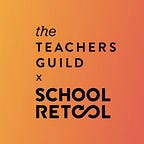Reflections from #CivicVoices and Questions About the Future
by The Teachers Guild team
“What’s civics?” This is the question we heard educators ask over and over again during our fall Collaboration, when our community embarked on a design journey to reinvigorate civic learning in their schools. Today, reinvigorating civics feels even more relevant than when we launched it this past September.
We saw diverse solutions during our design challenge and are still exploring what civics can mean in schools. What we have learned, however, is that at its best, civics is much more than a contained discipline or a single class. As Emma Humphries, Chief Education Officer at iCivics, whose mission is to inspire students to be active participants in U.S. democracy, put it:
“It’s education that should inspire our students towards a lifetime of informed, fierce, and tireless engagement in their communities and in public life.”
We love this definition and wonder what it would take to achieve it. How might we reimagine civics as an integral part of school so that all students know and believe in their unique power to make a difference in the world?
This question is important right now because the outcomes of the presidential election have opened up a flurry of new discussions about citizenship, how to make our voices heard, and what the future of civic engagement will look like.
For example, teachers are asking how to maintain safe, supportive and inclusive classrooms in this post-election environment where white nationalistic agendas have been bolstered and minority groups targeted. Bright, Medium’s education column, shared stories from schools across America the week after the election, highlighting this struggle. For example, they shared a story of student-made signs segregating water fountains by race in a Florida high school.
It is devastating to hear these stories and think of their impact on students. It is also hard to imagine being an educator right now, holding up inclusive environments during such a divisive period.
But still, just one week into the post-election heat, we culminated our #CivicVoices project with something quite optimistic: we brought together students, teachers and partners at the Chavez Middle School for Public Policy, located on the eastern edge of Washington D.C., to discuss new and better ideas to support the future of civic education. The school serves low-income youth in a predominantly black community, and is only miles away from Capitol Hill and the White House. We did this because, despite divisive national conversations, we know that teachers and students have so much energy and optimism to make schools incredible places of learning, where all students feel welcomed and heard.
At this workshop, we met Teniyah, an 8th grader who is passionate about shaping her school. “I wish that all students felt as comfortable about who they are in classrooms,” she said, responding to This is Me and I Matter, an idea submitted by a Nicole Ayala, who teaches high school in Portland, Oregon. Ms. Ayala’s solution asks students to submit videos about who they are and what they want others to know about them, in an effort to expose the mismatch of stereotyping and self-identification. Like so many ideas we reviewed, this solution both reflects the divides that exist in schools today, but also the readiness to work towards bridging these gaps and preparing students for active public engagement.
Many of the ideas that emerged during our Collaboration are starting points to help students engage and make their voices known. Of course, we know that no one idea is the silver bullet to solve a difficult challenge, just as we know civics is one important question of many that we face in education.
As we continue to address these challenges at The Guild, we feel it’s important to listen to each other right now. That’s why we’re asking you to inform our next set of Collaborations by sharing what your questions are.
What sorts of challenges do you want to take on this spring with this optimistic community of educators? It can be on any subject or any topic. What do you most want to tackle with us?
Here is our ask: share your How Might We question using #MyHMW on Twitter or in the comment section below. To invite others to discuss your topic and brainstorm ideas, we suggest beginning your question with the words ‘How might we.’ Don’t forget to add the hashtag #MyHMW.
Thank you for helping to make your students’ voices heard and for showing up each day with optimism and hope.
With Gratitude,
The Teachers Guild
